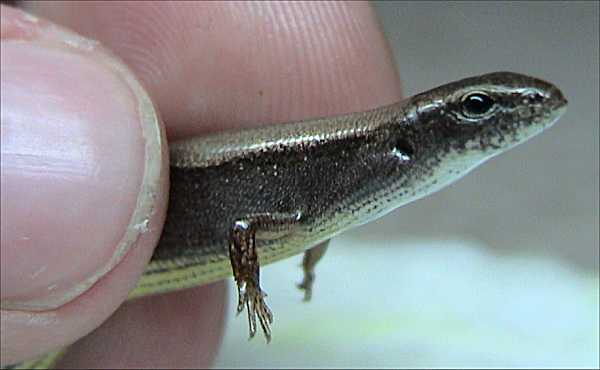- Ground Skink
regnum =Animal ia
phylum = Chordata
classis = Reptilia
ordo =Squamata
subordo =Sauria
familia =Scincidae
genus = "Scincella "
species = "S. lateralis"
binomial = "Scincella lateralis"
binomial_authority = Say, 1823The Ground Skink ("Scincella lateralis"), also known as the Little Brown Skink, is a small
species ofskink found throughout much of the eastern half of theUnited States , and into northernMexico .Description
This is one of the smallest reptiles in North America, with a length of 3 - 5.5 inches (7.5 - 14.5 cm). Its back is typically a coppery
brown color with awhite oryellow underside, and like most skinks has an elongated body and short legs. Transparent disks in the lower eyelids allow it to see with its eyes closed (Beane 2006, Palmer et al. 1995).Range and habitat
The Ground Skink is found throughout much of the Eastern United States, from
New Jersey ,Ohio [http://www.dnr.state.oh.us/tabid/11846/default.aspx] , andKansas south toTexas andFlorida , as well as into northernMexico . It is absent from higher elevations in theAppalachian Mountains . It lives in a variety of habitats, including deciduous or mixed deciduous/coniferous forests, hedgerows, and the edges of streams and ponds. It does require a deep substrate, such as leaf litter.Habits
This is a
fossorial species, spending the majority of its time buried in leaf litter on the forest floor. Unlike other skinks, it seldom climbs trees. Its usual means of locomotion is to wriggle through the leaf litter with undulating movements (Lizards of Georgia). It may dive under water when pursued, although normally avoids wet areas. It is largely diurnal, but may be active at night as well. It hibernates during the coldest months, but may be active in almost any month of the year inNorth Carolina (Palmer et al. 1995). As befits a tiny lizard, the home range of an individual may be as small as 20 square meters (Natureserve). The diet of the Ground Skink consists of smallinsect s, spiders, and other arthropoda, such as isopods. Ground Skinks are, in turn, preyed upon by snakes such as the Eastern Racer, Ringneck Snake, andScarlet Kingsnake . Predatory birds of woodland habitats, such as theBarred Owl and theRed-shouldered Hawk , also feed upon Ground Skinks. Even theEastern Bluebird has been observed feeding on this tiny lizard (Palmer et al. 1995, Beane 2006).Reproduction
The Ground Skink lays small clutches of 1-6 (usually 2-3) eggs in moist soil, rotting logs, or under rocks. Eggs are laid during the summer, March through August in the Southern United States. There may be more than one clutch per year. In contrast to "
Eumeces " species, the female Ground Skink does not guard its eggs (Beane 2006). Eggs hatch in one to two months, and young are sexually mature at one year of age.Conservation status
The Ground Skink is a widespread and common species in most of its range. It is of conservation concern only on the northern edge of its range.
References
*EMBL species|genus=Scincella|species=lateralis
* [http://www.uga.edu/srelherp/lizards/scilat.htm Lizards of Georgia and South Carolina] --accessed 15 May 2006
* [http://www.bio.davidson.edu/projects/herpcons/herps_of_NC/lizards/Sci_lat.html NC Herps] --accessed 15 May 2006
* [http://www.natureserve.org/explorer/servlet/NatureServe?searchName=SCINCELLA+LATERALIS+ Natureserve] --accessed 15 May 2006
* [http://www.terrapinbook.com/pdf/herpchecklist2002.pdf Terrapin Book] --accessed 23 September 2007
*Jeff Beane (2006). Love Skinks. "Wildlife in North Carolina 70:" 14-19. ISSN 0043-549X.
*Bernard S. Martof et al. (1980). "Amphibians and Reptiles of the Carolinas and Virginia". Chapel Hill: University of North Carolina Press. ISBN 0-8078-4252-4.
*William M. Palmer, Alvin L. Braswell, Renaldo Kuhler (1995). "Reptiles of North Carolina". Chapel Hill: University of North Carolina Press. ISBN 0-8078-2158-6.External links
Wikimedia Foundation. 2010.

